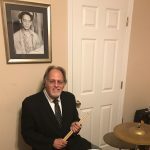Hal Smith: You are best known among Traditional Jazz fans as a cornetist, but can you tell us about the instrument you started with?
Chris Tyle: I started on piano at 11. It was the usual thing, scales, exercises, the classics. I found it tedious. I learned to read fairly well and found some boogie-woogie folios in our sheet music cabinet that my mom had played at one time—pieces by Meade “Lux” Lewis, Pete Johnson, et. al. A Fats Waller folio, too.
I worked on trying to play these and one time played one for my teacher, a Swedish woman in her 60s. She was not happy! At about 12 I started playing drums in the grade school band. I also had some lessons from a drummer who some years later I worked with (when I played cornet). I played drums throughout high school—they wouldn’t let me play cornet or trumpet because there was a shortage of drummers. I was disappointed with that as I wanted the reading experience.
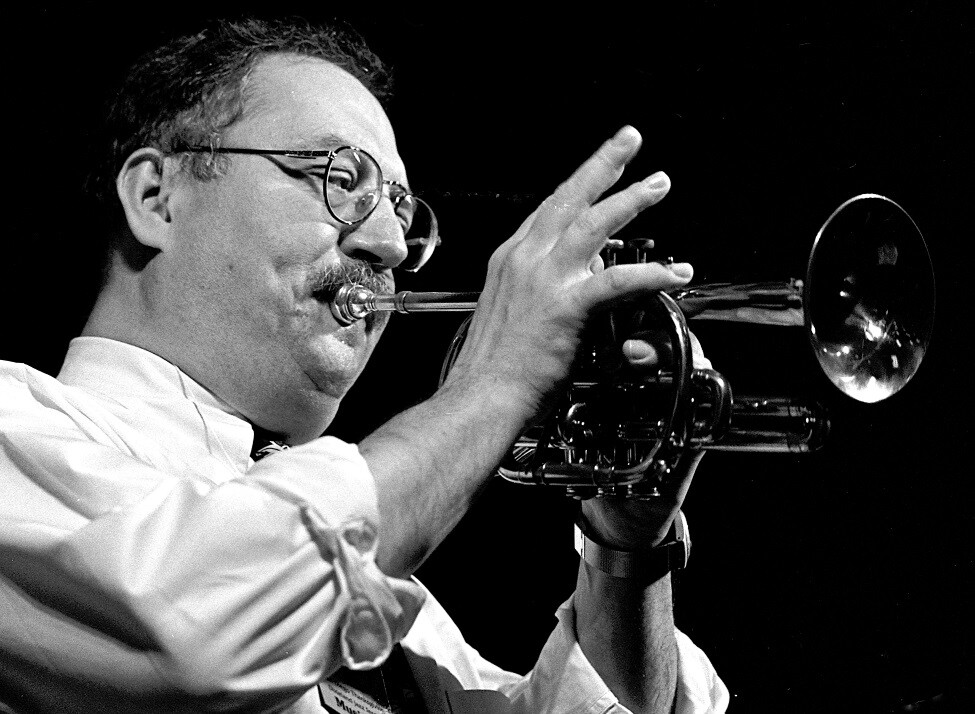
There was “Drum DNA” in your background (your father). What are some details of his career?
My dad, Axel Tyle, was born in Copenhagen, Denmark, in 1912. He came to the US in 1917 with his mother and they settled in Portland, Oregon. When he was 12 he heard a black jazz band that was with the circus, playing for a backyard party near his house. It had a huge impact on him. I think at that time he was studying drums and cornet (by the time I came along he no longer played cornet). He became a professional musician as a teenager, playing mostly with small dance bands in the Portland area. He was also interested in radio and electronics, and although he continued playing professionally, he was making most of his living involved with radio and television (he later became an instructor at Multnomah College in Portland).
In the early 1940s he played with a five-piece jazz band that was, in essence, the precursor of the Castle Jazz Band, which was led by banjoist Monte Ballou. The CJB was “officially” formed after WWII, although they had made a couple of records during the war. He was with the band for about three years post WWII but he and clarinetist Bill Pavia left over a disagreement on the direction of the band. They wanted to play more in an Eddie Condon-Chicago style manner, but Ballou was following more along the lines of Lu Watters and Turk Murphy, with banjo and tuba. But my dad did in subsequent years play with the CJB now and then.
He was also an avid record collector, inspired by a late-1930s Esquire Magazine article titled “Collecting Hot.” He and a couple of other Portland area collectors (among them banjoist Monte Ballou) started searching high and low for rare records. He had quite a wonderful collection, with many “new old stock” gems picked up from an out-of-business bicycle shop that also sold records. I inherited the collection but sadly sold it in the 1980s to help fund the purchase of a house.
During World War II he was stationed in Boston, and went to the Savoy Club there to hear trumpeter Bunk Johnson and clarinetist/soprano saxophonist Sidney Bechet. Pops Foster was also in the band on bass.
On the night my dad was there their drummer became ill and my dad offered his services. Sidney was skeptical but had my dad join them on a set. The first tune Sid called was an uptempo version of “I Know That You Know.” My dad had no problem with the tempo so he played the rest of the evening with them. But my dad didn’t say much else about the experience except “Bunk was a nice old man.”
My father was lucky as a young man to have had the opportunity to hear a number of popular dance bands that came through Portland on tour. Just some of the groups he heard were Ted Lewis’ Orchestra (with cornetist Muggsy Spanier, clarinetist/saxophonist Jimmy Dorsey, and trombonist George Brunies), Glen Gray and the Casa Loma Orchestra, Duke Ellington, Isham Jones—just a few of the bands he mentioned hearing.
He also got to meet Louis Armstrong and his drummer at the time, “Big Sid” Catlett. My dad said he was playing with a group in the studio of radio station KGW, and Louis’ band was in the next studio, separated by a soundproof window. My dad had his back to Sid but they were both digging each other. Sid had a great influence on my dad, as he has on me. He’s my favorite drummer.
Did you hear a certain hornman in person, or on record, who inspired you to take up the cornet?
When I became interested in boogie-woogie, I read the book Jazzmen because there was a section in the book dedicated to that style and players. So I read the whole book, and was fascinated by the history of early jazz. I dreamed about playing cornet after hearing Bix, King Oliver, and the Armstrong Hot Five reissues on LP.
My mom and dad were dead-set against my playing cornet—I still have no idea why. Probably because that’s what I really wanted to play; not drums or piano. My sister felt sorry for me and bought my a used Olds Ambassador cornet for my 15th birthday. I got a book with the fingering and some elementary exercises, and off I went.
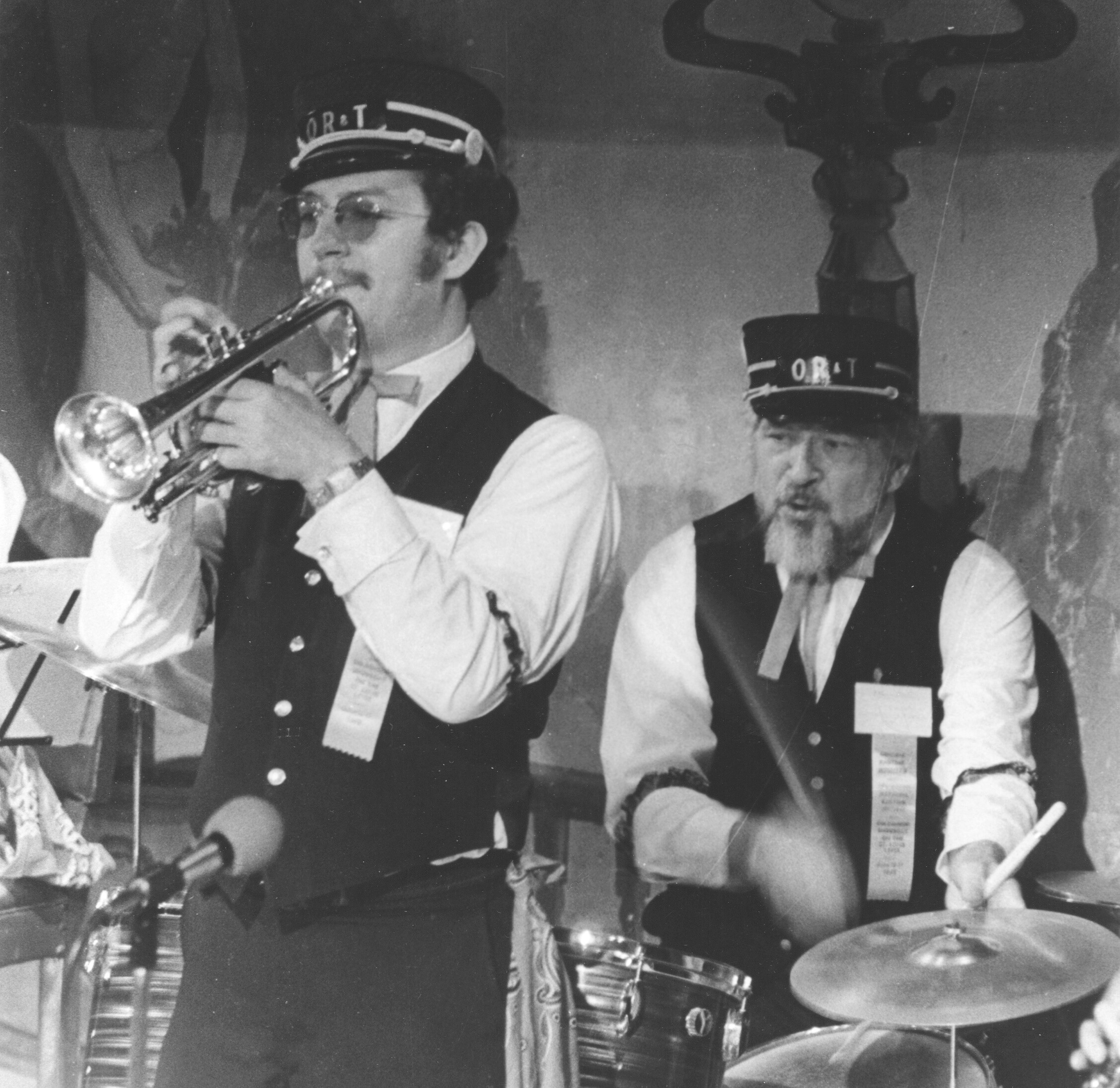
I continued to work on it on the sly, but also at this time I would accompany my dad to rehearsals of trumpeter Don Kinch’s Conductors Ragtime Band. They had weekly sessions in the storage area of Don’s string instrument repair shop. Eventually after several years of playing at home I brought my cornet in and played a bit at one of these sessions. It was pretty bad but Kinch gave me a bit of encouragement so I continued and eventually ended up playing with his band.
What were some of the bands you worked with when you first started on the horn?
Except for Kinch’s band, there really weren’t many bands around Portland at the time in the early 1970s. There was no one my age interested in the music—only guys twice or thrice my age. So it was difficult for me to get any kind of playing experience. When I heard where there was a gig, I would go and listen and perhaps get lucky enough to have a sit-in.
The first time I played the cornet in public was at a gig led by clarinetist Jim Beatty, on their weekly one-night-a-week session in Oregon City at McAnulty and Barry’s Tavern. Playing cornet with them was Danny Alguire, and he was nice enough to let me sit in and VERY encouraging. Many of the older guys were a bit condescending and there was, in a way, a certain very high bar for cornet players in the Portland area, because of musicians like Kinch, Ernie Carson, and Jim Goodwin. But by the time I was beginning to find the occasional gig, Carson and Goodwin were gone and if I was lucky I might pick up a gig here and there. Not very many though. I do remember sitting in with a band of guys just a bit older than myself, with the amusing name of the Fiendish Glee Club.
In 1979, you joined one of the most famous Traditional Jazz bands: Turk Murphy’s San Francisco Jazz Band.
I joined Kinch’s Conductors in 1977, and played with them through 1978. I had done a little session in 1978 with Turk (who was on a hiatus due to the closure of Earthquake McGoon’s), clarinetist Bob Helm, tubaist Bill Carroll, banjoist John Gill, and yourself on tuba. Turk liked my playing and we kept in touch.
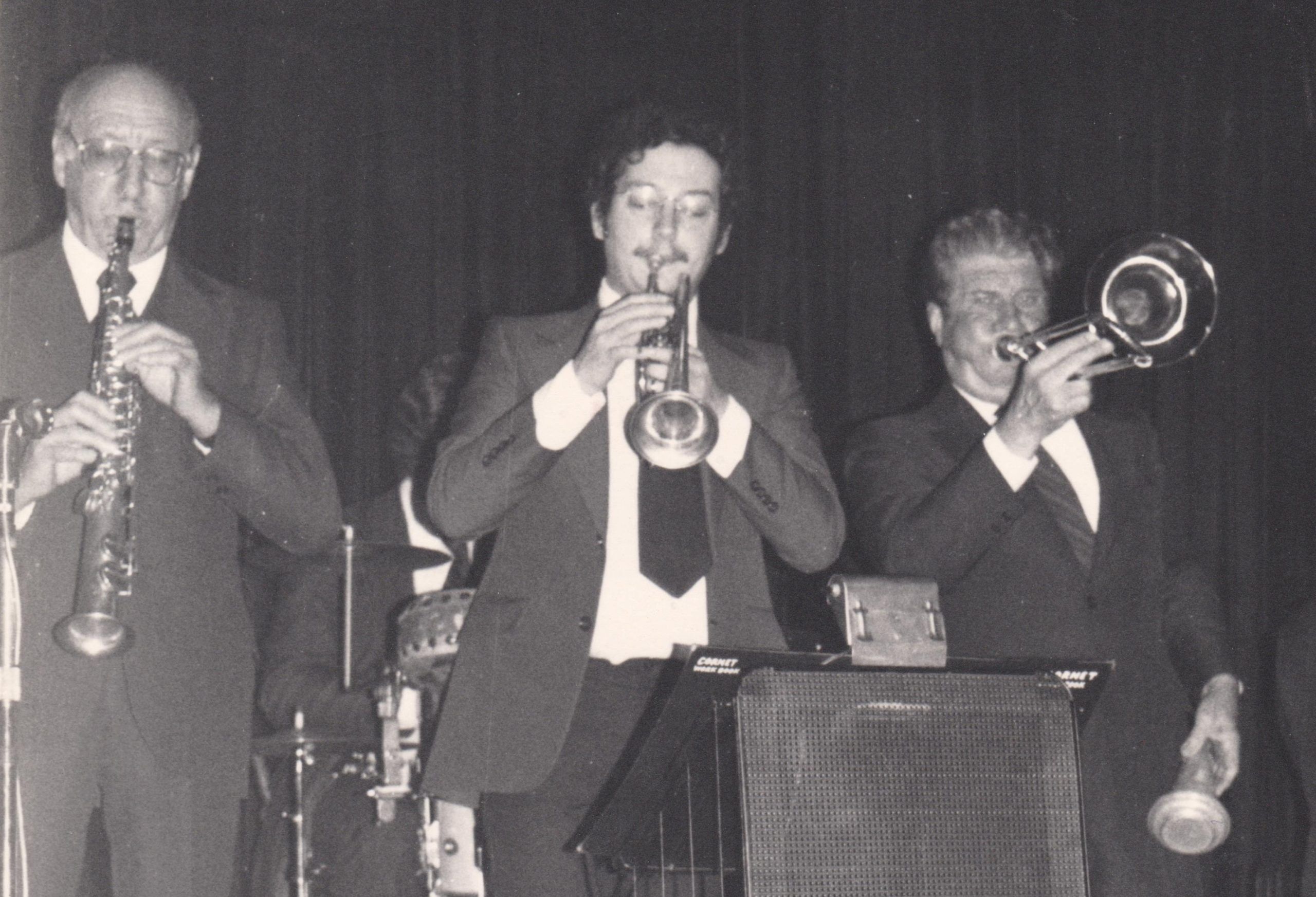
I decided to quit Kinch’s band and my day gig in Portland and move to San Francisco, thinking perhaps I might get the call to play with Turk, which did happen in early 1979. But things didn’t work out—for a LOT of reasons. Much of it was due to my inexperience. Because I was never allowed by my parents to play the cornet, there was no way for me to take lessons to become a reader, so I learned everything by ear. I could “spell” as they used to say about the old-time New Orleans musicians, but still to this day I don’t consider myself a reader nor do I like to read.
I had joined the Murphy band at a particularly stressful time for him. He had, as we now say, “a lot on his plate.” The club where I played on the Embarcadero on the Bay was no way near what the club he had owned on Clay Street had been, and people just weren’t coming to hear the band. Also, me being the guy who had replaced Leon Oakley, (who had been in the band for many years) fans took a dislike to me, as though somehow I was responsible for Leon no longer being in the band.
All of this stuff was difficult for a 23 year old from, basically, the sticks—I was in over my head.
Eventually I just felt it was best I leave the band and return to Portland. However, the experience was very worthwhile. There were musicians in Portland and the Bay Area who were betting on how long I would stay with the band. But at least I had the guts (something Turk accused me of not having) to go and do it. Better to try something and get knocked down than to not do it and regret it. So that didn’t work out, but I went back to Portland and within two years I had a band that was working full-time while a lot of those guys who were snickering about me taking the job were still playing their few casual jobs here and there. “Pick yourself up, dust yourself off, and start all over again.”
While you were in the Bay Area, who were some of the other Traditional Jazz musicians you played with?
I didn’t play much with other musicians because I was mostly working with Turk. But I did sit in a bit with Ev Farey’s Golden State Jazz Band, and I remember a few other gigs—sitting in with Mike Lipskin at the Washington Square Bar and Grill, and playing with Robbie Schlosser’s Magnolia Trio. There were other “legendary” guys I remember playing with—clarinetist Bill Napier, trombonists Bob Mielke and Bill Bardin, and pianist Burt Bales.
I was very fortunate to spend an afternoon with Lu Watters. He was a fabulous guy and I wish now I had been able to visit him again, but that just never happened. I told him I was working with Turk, he chuckled and said “you have my sympathies.” At the time I was a bit taken aback, but eventually I understood. Guys like Lu, Turk, Helm—were old-school and came up playing all kinds of gigs—many of them dreary dance band gigs. I never had that opportunity, because by the time I was playing everything was rock ‘n’ roll.
I think if Turk had given me some encouragement, things would’ve worked out much better. But that wasn’t his way, so he just gave up on me and went out of his way to be unpleasant. So, instead of giving me some time to work things out, he let me go and hired George Rock—a fabulous trumpet player who spent years with Spike Jones, but not a traditional jazz player. He could read all of Turk’s charts, but there was more to playing in that band than just reading the notes. I think he lasted about six months and Turk hired Bob Schulz, someone who understood the music, was a great reader and a superb jazz player.
Over the years all of the guys in the band with me (Helm, Gill, Clute, and Bill Carroll), told me: “Turk gave you a tough time and you didn’t deserve it.” In a strange twist of fate, in 1985 at the Golden (Colorado) jazz festival, Schulz had to leave suddenly because his wife had gone into labor back in San Francisco. Turk asked me to play their last set at the festival. I was very surprised, and had a great time. Afterwards he asked me where to send a check, my response was, “No need—I did it as a favor.”
After leaving the Murphy band, what was your next move? You were heavily involved with playing swing music, and you led a band that was one of the very first “swing revival” groups.
My ego was a bit deflated after the experience with Turk, although I now look upon it as an important learning experience, and it was during that short stint that I made my first recording, the LP A Natural High, which subsequently came out on CD.
Before I left for San Francisco, I had become friends with a string bassist named Dan Presley. Dan was playing with an extremely popular Django Reinhardt-inspired group called Everything’s Jake (actually one of the first of its kind playing in the US). When I returned to Portland, Dan and I decided to form a quartet to play mostly 1930s music.
I liked the name “Wholly Cats,” which was a tune written and recorded by Benny Goodman and Count Basie. In this partnership, Dan was the businessman and I was the musical director, which worked perfectly. We started picking up little jobs here and there, often subbing on gigs for Everything’s Jake. They had a steady gig at a restaurant/nightclub in downtown Portland called the Brasserie Montmartre, and we frequently played there in the early 1980s.
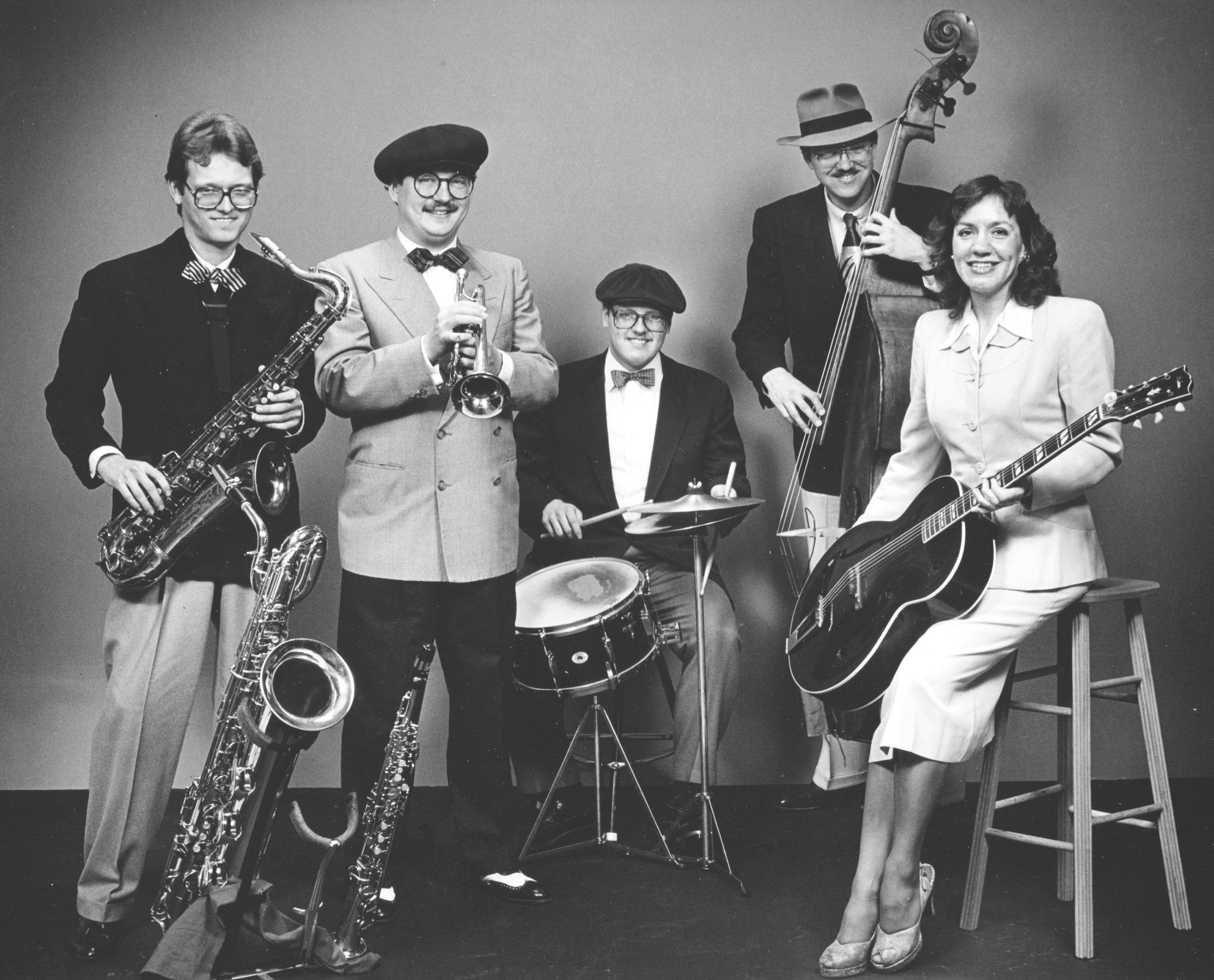
In 1982 we heard that a 1930s-style nightclub was going to open in downtown Portland, and Dan knew one of the partners. Through his good work we secured a five-night-a-week gig at the club, called Father’s American Broiler and Nightclub. By this time Becky Kilgore had joined the group on vocals and guitar, and her talent brought a lot of recognition and fans to us. We were also able to expand the band to a quintet and added an excellent drummer by the name of Hal Smith. By this time we were getting a lot of recognition by the local press and we made several appearances on local TV. Prior to your joining us we cut an LP which helped the band a great deal, too.
During our stint at Father’s we had some stellar guests: cornetist Bill Berry (known for his work with Duke Ellington’s Orchestra and on Concord Records); pianists Butch Thompson, Dave McKenna and Dave Frishberg; and tenor saxophonist Scott Hamilton. Frishberg was so taken with Portland he moved there just a few years later.
Sadly, Father’s began to falter and we were replaced by a popular local trio, but not long after the club closed for good. Wholly Cats continued on for a short while but without a regular gig there was a parting of the ways. I ended up getting a non-music gig, but continued playing casual gigs. In 1985 I was hired to play drums with the popular jazz festival band Stumptown Jazz, and worked with them until late 1988.
Also during the 1980s I began making recordings with Hal Smith’s Down Home Jazz Band and the Rhythmakers.
In the late 1980s, you decided to try playing music for a living in New Orleans. That was apparently a good move, as you lived there for quite awhile.
Banu Gibson heard me play drums with Stumptown on a joint concert she did with them and her New Orleans Hot Jazz in 1988. Not long after she asked me to play with her band on a trip to Europe: a jazz festival in Hanover, Germany and the famous “Oude Stijl” (Old Style) festival in Breda, Netherlands.
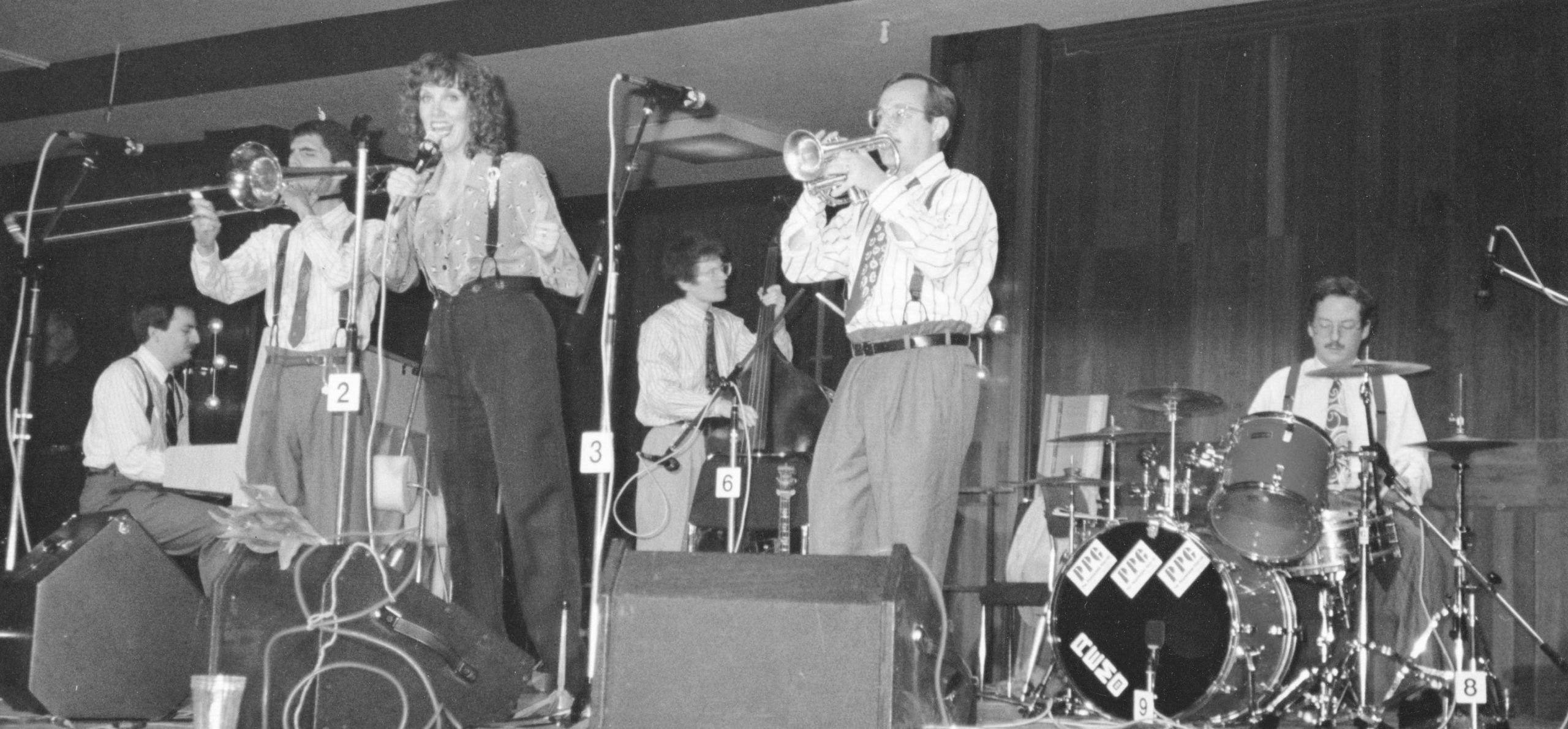
As a warm-up to the gig, she brought me to New Orleans to play a night with the band at Mahogany Hall. I had never been to New Orleans, and even though I was there for only a couple of days, the city made a great impression on me. Once back in Portland from the tour, I made the difficult decision to leave and give New Orleans a try, and with the encouragement of yourself, pianists Steve Pistorius and David Boeddinghaus, and clarinetist/saxophonist Jacques Gauthé, I took the plunge, and in January 1989 I drove from Portland to New Orleans.
Right from the get-go I was working with both Steve’s group and with Jacques, then other gigs started rolling in. I worked 368 gigs the first year I was there, oftentimes working two gigs a day. It was an unbelievable time! It was great to be there in a place with so many kindred spirits, musicians who really knew the music and lived it, rather than guys who just got together occasionally to play “Dixieland” without the knowledge of the early masters and recordings.
Who were some of the legendary New Orleans musicians you worked with?
Most notably was banjoist/guitarist/raconteur Danny Barker, who hired me to play his Thursday night gig at the Palm Court Jazz Cafe. Also in that group was clarinetist/saxophonist Pud Brown, and we played together for a year and a half. During my stint in New Orleans I also worked gigs with Percy and Willie Humphrey and trombonist Wendell Eugene, who were among the earlier generation of jazz players. And there were many gigs with expats—clarinetist Orange Kellin, pianist Lars Edegran, drummers Trevor Richards, Barry Martyn. and Andrew Hall.
What were some of the highlights of your residency in New Orleans?
Almost every gig was a treat to play. Of course, I loved having the six-nights-a-week gig at the Can-Can Jazz Cafe in the Royal Sonesta Hotel with my Silver Leaf Jazz Band—which I suppose was the highlight of my career for ten years. But there were other great gigs, too, especially with banjoist/trombonist John Gill when we played together at the Maison Bourbon.
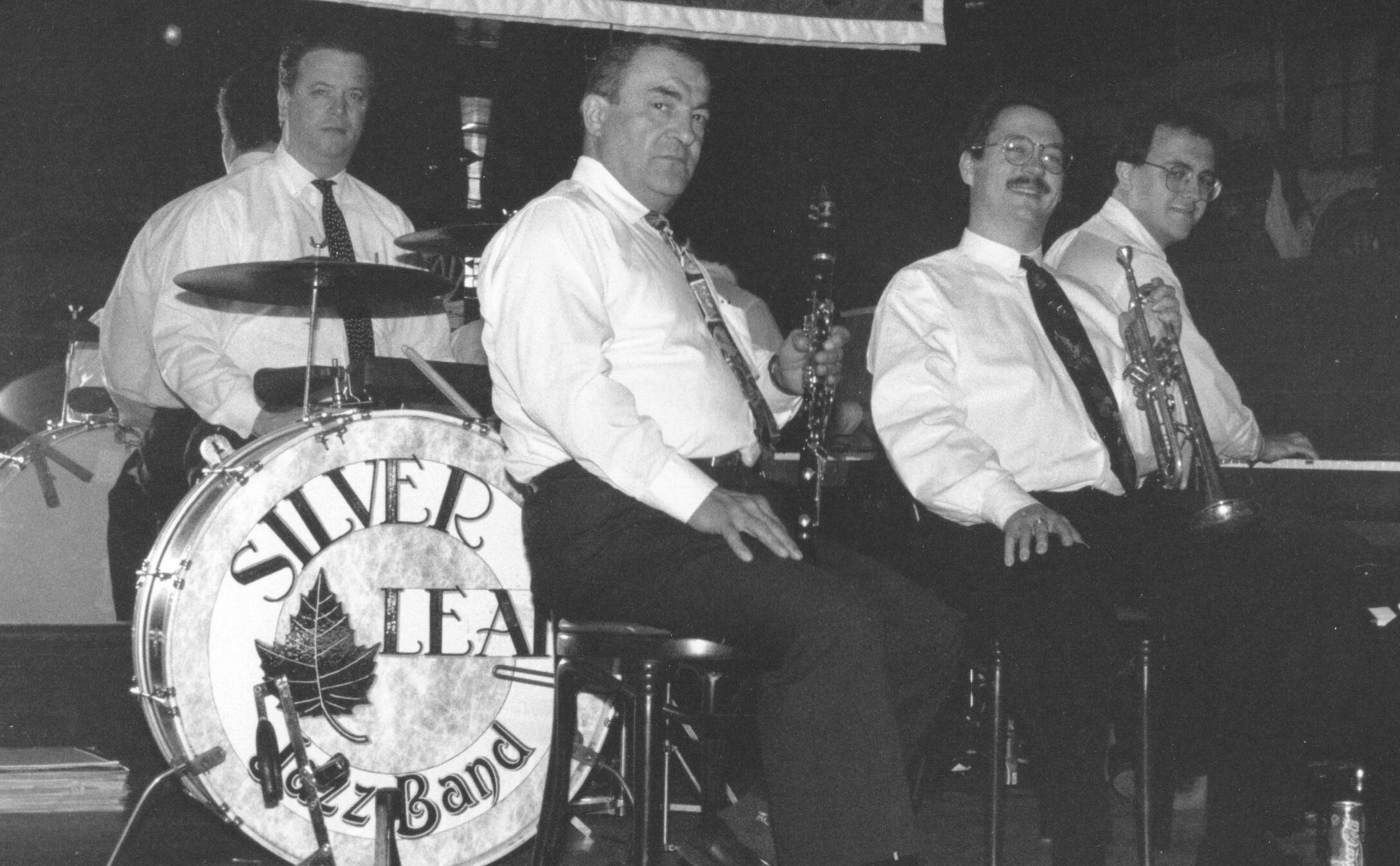
Hard work though—five hours at the Maison, then four hours at the Can-Can—both six-nights-a-week gigs with different night and day off. It was crazy. I lived most of that time in the French Quarter and sometimes could go home between gigs. But there were other jobs, too; working on the Natchez with Eddie Bayard’s and Duke Heitger’s groups; playing brunches with various musicians; little spot gigs with various bands, French Quarter Fest and Jazz Fest. French Quarter Fest was always an amazing time, with so many gigs it was hard to keep track. I would often go from one stage to another several times a day!
I would also like to mention some of the other great players I worked with, not only on my gig as leader but with other groups: trumpeters Duke Heitger, Charlie Fardella, and Chris Clifton; clarinetists Tom Fischer, Brian Ogilvie, Jacques Gauthé, Orange Kellin, Dan Levinson, Barry Wratten, Pud Brown, Jack Maheu, Tim Laughlin, Brian O’Connell, and Evan Christopher; banjoists Neal Unterseher, Amy Sharpe, and John Parker; pianists Steve Pistorius, David Boeddinghaus and Lars Edegran; trombonists Tom Ebert, Mike Owen, and Wendell Eugene; bassists Tom Saunders, Bernie Attridge, and James Singleton; drummers Hal Smith, Andrew Hall, and Barry Martyn.
I would also like to mention some of our “visiting firemen;” cornetists Dan Barrett, Mark Caparone, and trumpeter Jon-Erik Kellso; and drummers Pete Lay (leader of the Gambit Jazzmen in England) and Kevin Dorn. Likely a host others that I now can’t recall but were welcome!
Any anecdotes to share regarding musicians, gigs, etc.?
I don’t particularly have a great memory for things like this, but I do recall one time showing up at the Can-Can to play with my clarinet, but to my dismay found clarinetists Tom Fischer, Brian O’Connell, and Tim Laughlin engaged in conversation with trumpeter Duke Heitger! It seems I had booked myself out of a job! Actually it was Tom’s gig and Tim and Brian were just there visiting. I ended up going home as I didn’t want to send Tom Fischer home due to my mistake. So I went out and had a lavish meal at one of New Orleans’ great restaurants!
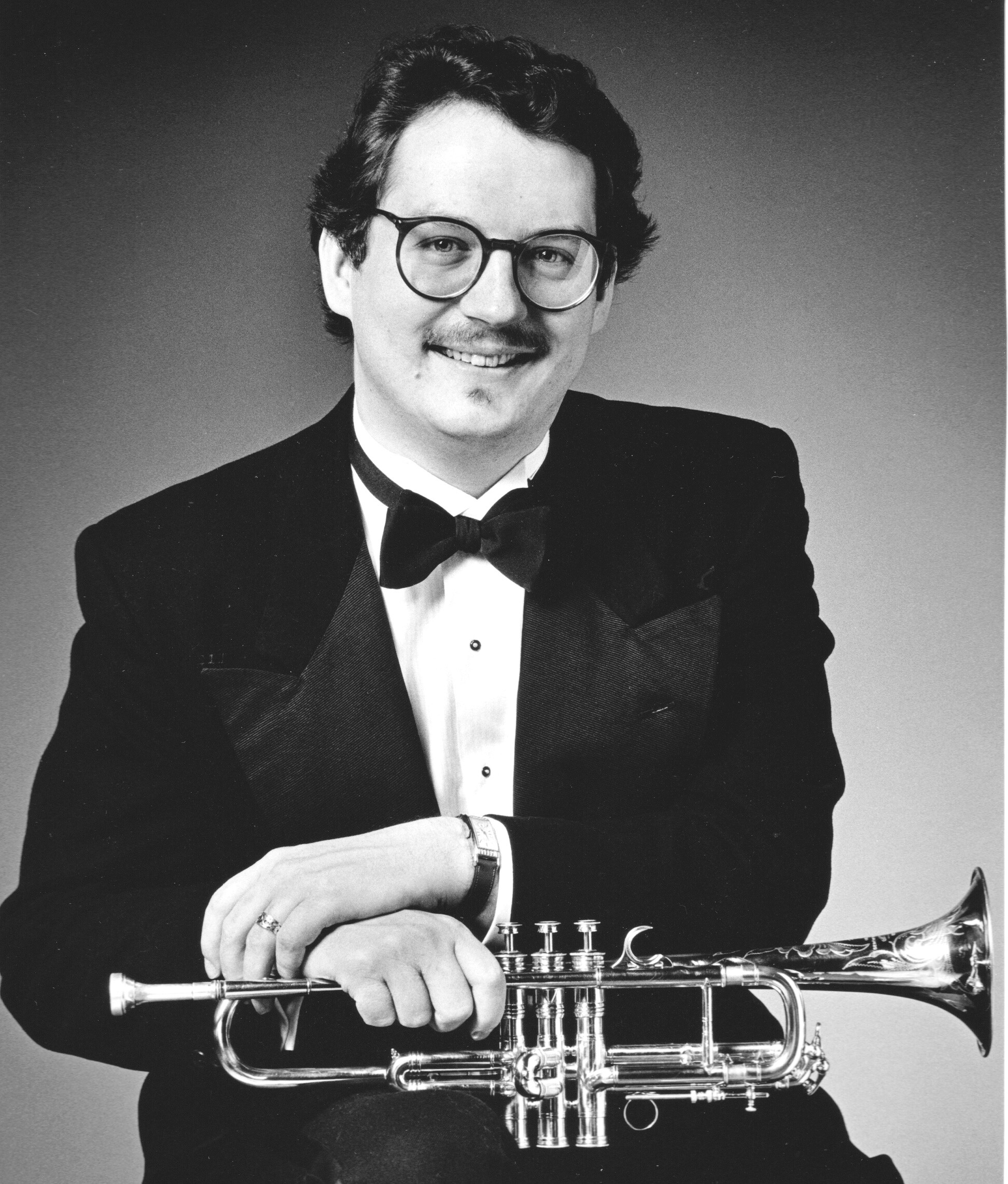
I have a funny recollection from when I was a little kid, watching a band my dad was playing with (probably Monte Ballou’s Castle Jazz Band). I don’t remember anything about the music, but I was fascinated with the musicians’ tapping feet!
It was on a gig with Trevor Richards where I met and played with both Danny Barker and Willie Humphrey—just a quartet: cornet, clarinet, banjo and drums. I wish now I had taped that, not only for the music but for the conversation between Danny and Willie, which consisted of priceless bits of New Orleans jazz history. That aside, I was eager to impress these two gentleman, so I played a set like Bunk Johnson. No reaction. So, the next set, I played a bit like “Red” Allen, knowing both of them had worked with Red.
I was taking a solo and I felt Willie staring at me (I can’t imagine what he was thinking!) but due to his reaction I played the rest of the gig in the “Allen” mode. When we finished, Danny Barker came up to me and said, “Hey Tyle…I can hear you like Red Allen. Give me your card and I’ll keep you in mind.” Not long after he hired me at the Palm Court Jazz Cafe.
You recorded extensively from the late 1980s to the late 1990s. What are some of your favorite albums?
Like many musicians, I don’t really like listening to my own recordings, but I would say my absolute favorite recording is Great Composers of New Orleans Jazz by the Silver Leaf Jazz Band. The band really came together nicely on that plus it was a great selection of tunes.
I also like the session I did with trombonist Mike Owen’s Woodland Jazz Band. As I mentioned before the Down Home Jazz Band sessions, and those with John Gill’s Dixieland Serenaders. Just the other day I listened to a session by the Frisco Syncopators, with the Bob Mielke on trombone, George Probert on soprano, Bill Carroll on tuba, Steve Pistorius on piano, Amy Sharpe on banjo, and Mr. Smith on the tubs.
It sounded terrific—what a great band! So, sometimes when I go back to listen to things I’ve done, I find I really DO enjoy them! At the end of this article is a selected list of some of my favorite recordings.
On the subject of recordings, I was pleased that one of the Silver Leaf Jazz Band tracks was used in Ken Burns’ Jazz. It’s a track from the tribute we did to New Orleans trumpet player Bunk Johnson titled Bunk Remembers (a medley of “Make Me a Pallet on the Floor” and a tune Bunk called “Makin’ Runs,” which he said was played by Buddy Bolden). I believe the SLJB was the only contemporary group aside from those ensembles led by Wynton Marsalis used in the first episode, “Gumbo: Beginnings to 1917.”
I do have an anecdote to relate at this point about a recording I made with New Orleans clarinetist Tommy Sancton. After I returned to Portland I used to listen to a traditional jazz radio show on local station KMHD-FM. One morning I was listening to a selection thinking, “I wonder who that drummer is? He’s really got the right idea about what to play!” I listened a bit more, and then realized—it was me! I hadn’t heard the session in years and could identify all the musicians except myself!
What brought you back to Oregon from New Orleans?
My late sister Judy had been trying to get me to move back to Portland for quite a few years, but I knew it would be a hard time for me there financially so I stayed in New Orleans until October 2002 when the Can-Can closed. At that point the outlook for me was not particularly rosy; I knew I couldn’t make it financially with just the occasionally sub gig or spot job. So I made the decision to return to the West Coast where my siblings were. Sadly, as the saying goes, “you can’t go back” and I found it a struggle to make ends meet.
Former Stumptown Jazz trombonist Pat O’Neal hired me to play with his band on the riverboat “Queen of the West,” but this was a once a week gig, and it was an all day cruise with one set of playing before the cruise and one on the boat, with a lot of down time and usually the same show each cruise. Not my thing, really, but I soldiered on for as long as I could.
I also played quite a bit with a quartet called “Combo Deluxe,” based in Tacoma, Washington, with guitarist/banjoist Candace Brown and her bassist husband Dave. In addition I had a bit of work on clarinet with vocalist and guitarist Retta Christie (with Jim Goodwin in piano). When Lloyd Byassee retired from the Titanic Jazz Band based in Southern California, I was hired to play drums and occasionally cornet.
I also did quite a lot festival work subbing for various musicians. At one time or another I subbed with the High Sierra Jazz Band, the New Black Eagle Jazz Band, the Climax Jazz Band and the Paramount Jazz Band. I also made a number of tours with Orange Kellin’s New Orleans Blues Serenaders. Then I got a call to play a musical in Paris—which would turn out to be a life changing experience for me.
What influenced your decision to emigrate to France?
In 2006 I was contacted by pianist David Boedinghaus about the possibility of playing cornet with a group for a musical based in Paris. Up to that time I had made a few visits to France and was very taken with it. The band, the writer/director, the producer, and the star performer all met up in New Orleans for a little run though of some material. A few months later I was on a flight to Paris.
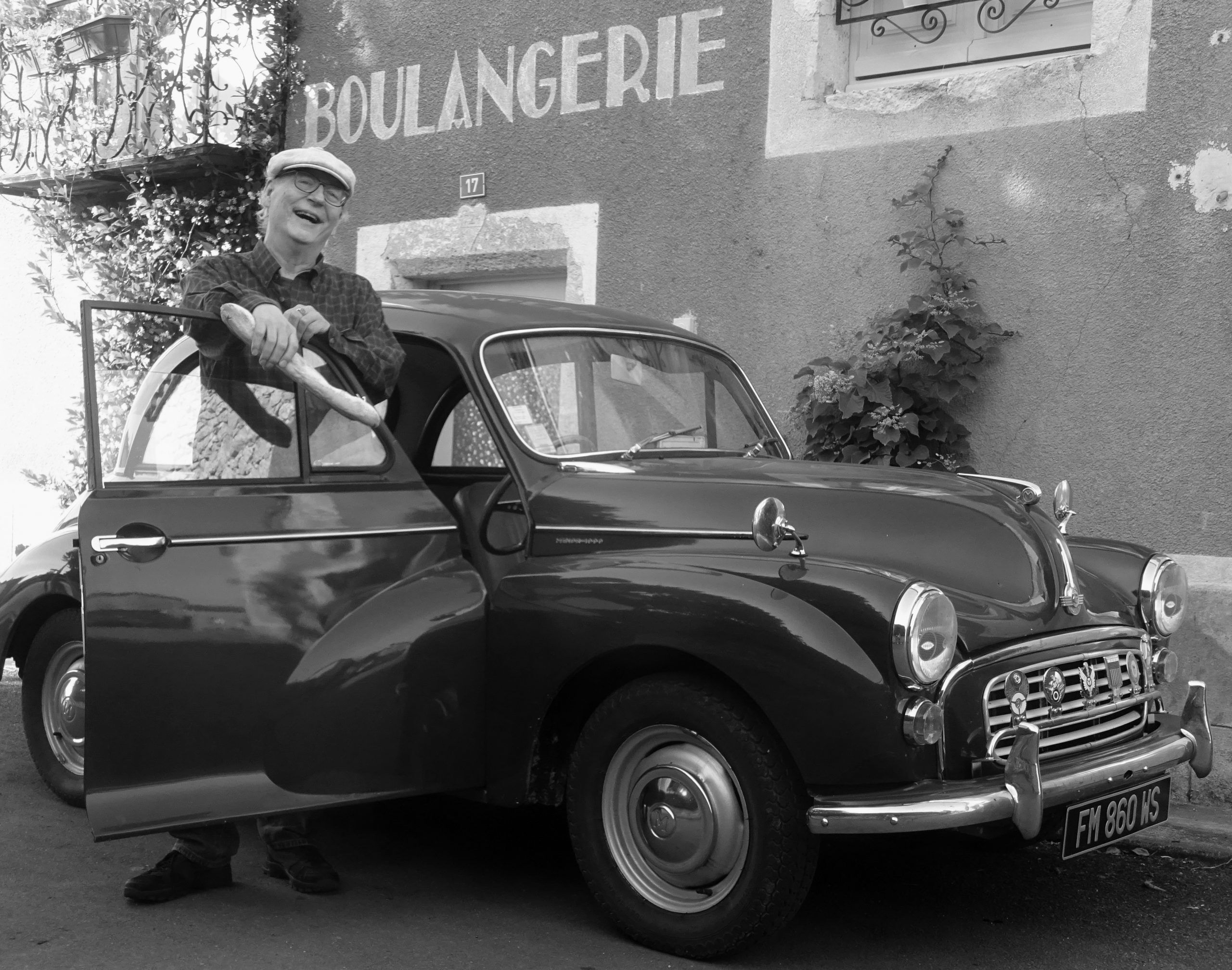
This musical, A la Recherche du Josephine, was a melange of the life of Josephine Baker set partly in the aftermath of Hurricane Katrina and partly in Paris. It sounds strange, but it worked really well and thanks to the fabulous actress and vocalist Nichole Rochelle it was a huge hit!
We toured France and Spain as a warm-up, and one of the places we played was a village near the Dordogne river named Sarlat-le-Caneda. I was really taken with the area. Following that visit, I made more trips to the Dordogne region, especially when I was doing gigs in England with my friend Pete Lay’s Gambit Jazzmen.
When my sister passed away at the end of 2014, I came into a little inheritance which gave me the means to make a move. In the late spring of 2015 I came here to scout for a place to rent, and when I stayed in the village of Monpazier a rental literally fell in my lap. After a weekend of soul-searching I decided to take the pluge; I sold my house in Portland, most of my belongings and made the move to France in October 2015.
In late 2017 I bought a house in a village not far from Monpazier called Villereal, and this is now my home. I’m lucky in that I’ve met many very nice English expats here, and even though my French is minimal I manage to get along pretty well with the locals. My life is basically quiet and idyllic, the only downside is that I was diagnosed with prostate cancer in the summer of 2018. I am undergoing treatment for it and hopefully I’ll be around for awhile longer to enjoy not only my retired life here in France but also playing a bit more music.
You have not been as musically active in recent years, though I see that you have once again taken up clarinet—which you started playing in New Orleans about 25 years ago.
One of the requirements for my living here was agreeing not to work, so I haven’t actively sought gigs because I would have to work for free, which is basically against my professional ethic. Also, as was reported in a past issue of The Syncopated Times, I basically retired from playing cornet because of the inherited condition I have called benign (or familial) essential tremor. (My father had it as do my siblings and their children and my son.)
I have the tremor in my left hand and jaw, which makes playing the cornet difficult as the tremor is exacerbated when under stress—like playing a music gig. I don’t have trouble with it so much when playing the clarinet or drums. I still can play the cornet, but I don’t keep my chops up and it can be an unforgiving instrument in that respect—more so, I believe, than the clarinet. I’m enjoying playing clarinet and even though I know I’ll never be on a level with the many great clarinetists I’ve worked with in my life, I can entertain myself at home playing tunes and having a little improvisational fun.
Do you have any musical plans for the future?
I’ll continue playing the clarinet. I’d like to get a little trio together, myself and a couple of sympathetic French musicians, to maybe play a couple of gigs a year at some local places. But the important thing is I’m not looking at this to make money—just a little fun for me and a little paying gig for the French musicians. I worked a gig in 1995 with Jacques Gauthé and some players from his area, who are still active as the Mississippi Jazz Band, and I’ve asked them if they’d like to do some gigs with me.
People often ask me, “Do you miss ‘home’?” There are things I miss about the US, but my home is now here in France. I have no desire to make another move after the one here!
Selected Discography
I’ve been on close to 60 sessions, and narrowing it down to just a handful is difficult. But of those these are some of my favorites. Unfortunately they are all out-of-print but likely easily available on amazon.com or ebay.com:
-Chris Tyle’s Silver Leaf Jazz Band, Great Composers of New Orleans Jazz, Good Time Jazz CD 15005
-Chris Tyle’s Silver Leaf Jazz Band, Tribute to King Oliver, Stomp Off CD SOS 1298
-Down Home Jazz Band featuring Bob Helm, Dawn Club Joys, Stomp Off CD SOS 1241
-Mike Owen’s Woodland Jazz Band, Without You for an Inspiration, Mr. Ory, GHB Records BCD-390
-Frisco Syncopators, San Francisco Bound, Stomp Off CD SOS 1211
-John Gill’s Dixieland Serenaders, Stomp Off CDs 1295, 1304 and 1321.
Quite a few of my recordings and videos are available on YouTube, and there is a “Chris Tyle” YouTube channel. – Chris Tyle
Note: Chris Tyle has also written extensively about jazz history for the jazzstandards.com website.
Hal Smith is an Arkansas-based drummer and writer. He leads the El Dorado Jazz Band and the
Mortonia Seven and works with a variety of jazz and swing bands. Visit him online at
halsmithmusic.com





